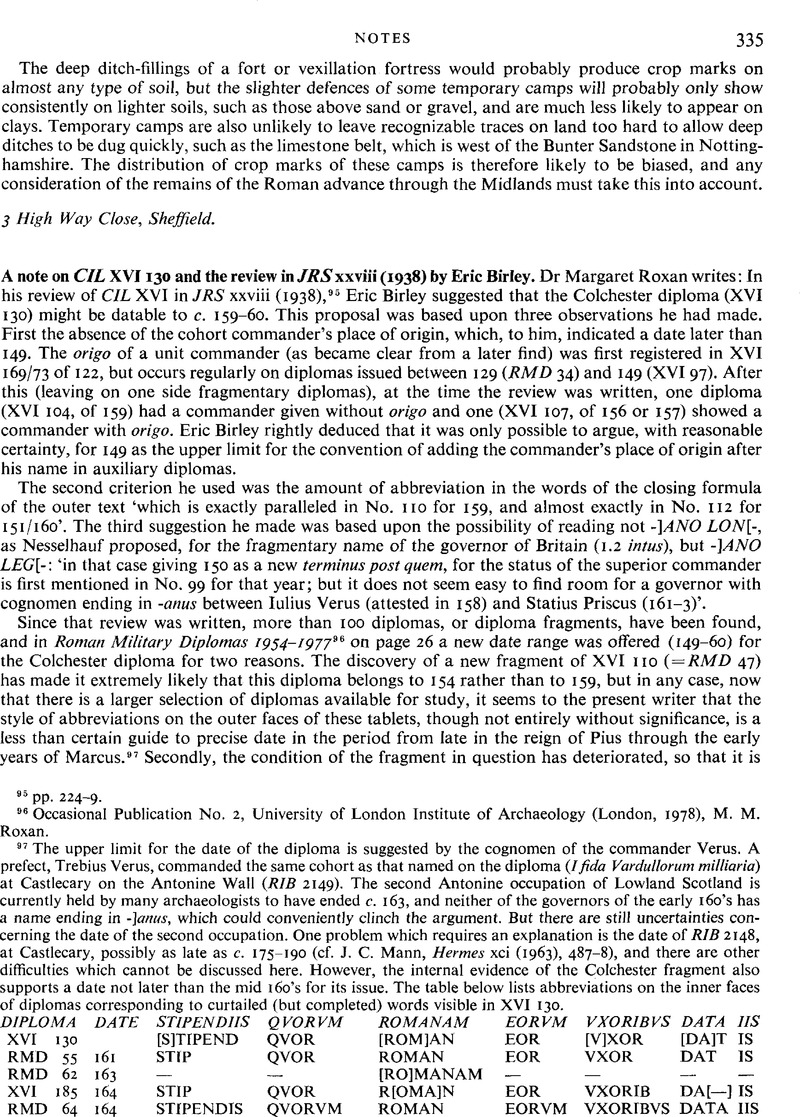No CrossRef data available.
Published online by Cambridge University Press: 09 November 2011

95 pp. 224–9.
96 Occasional Publication No. 2, University of London Institute of Archaeology (London, 1978), M. M. Roxan.
97 The upper limit for the date of the diploma is suggested by the cognomen of the commander Verus. A prefect, Trebius Verus, commanded the same cohort as that named on the diploma (I fida Vardullorum milliaria) at Castlecary on the Antonine Wall (RIB 2149). The second Antonine occupation of Lowland Scotland is currently held by many archaeologists to have ended c. 163, and neither of the governors of the early 160's has a name ending in -]anus, which could conveniently clinch the argument. But there are still uncertainties concerning the date of the second occupation. One problem which requires an explanation is the date of RIB 2148, at Castlecary, possibly as late as c. 175–190 (cf. J. C. Mann, Hermes xci (1963), 487–8), and there are other difficulties which cannot be discussed here. However, the internal evidence of the Colchester fragment also supports a date not later than the mid 160's for its issue. The table below lists abbreviations on the inner faces of diplomas corresponding to curtailed (but completed) words visible in XVI 130.


* There are few abbreviations in these two diplomas where there is more space since only one unit is named in either.
These selected words reflect a general trend towards less abbreviation observable on both faces of auxiliary diplomas in the period from 163 onwards. While not completely consistent for each word, the overall pattern is sufficiently well marked to suggest that the Colchester diploma belongs before it began, even though there are so few examples extant for the period in question.
98 XVI 178, 96, 179, 180, 97.
99 XVI 99.
100 RMD 46.
101 See Birley, A. R. in Epigraphische Studien iv (Köln-Graz, 1967), no. 26, 72–3.Google Scholar
102 cf. Alföldy, G., ‘Konsulat und Senatorenstand unter den Antoninen’, Antiquitas i, xxvii (Bonn, 1977), 170 and fh. 132.Google Scholar Even this exception to the convention may be explicable to some extent, since the diploma in question is very carelessly executed. Nesselhauf noted ten engraving errors, not including the fact that the unit commander appears as M. Longinius Longus intus, and M. Longius Longus extrinsecus. The omission of origo may be just one more example of haste and carelessness.
103 op. cit., 201 and fn. 270; cf. Eck, W., Pauly-Wissowa, , Realencyclopädie Suppl. 14 (1974), col. 662.Google Scholar
104 op. cit., 172–3.
105 Ada Arch. Acad. Scient. Hung, xxix (1977), 283–4.Google Scholar
106 op. cit., 164–6.
107 Inscriptiones Italiae xiii:i (Rome, 1947), 239.Google Scholar Fasti Ostienses, Rozpravy Československé Akademie Věd 67, 6 (Prague, 1957), 24. Both mistakenly followed Hiittl's restoration of Cn. Iulius Severus as consul in this year.